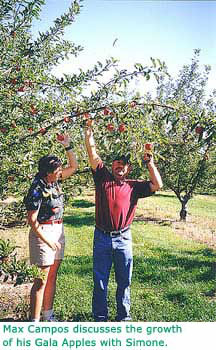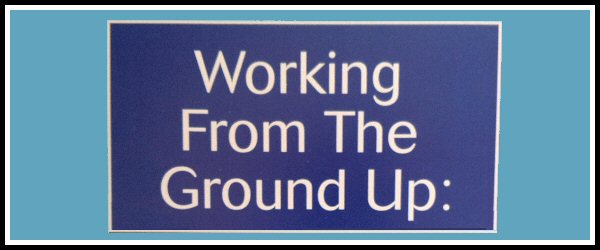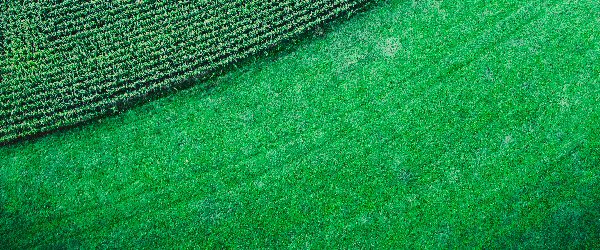Hispanic Orchardist Integrated Pest Management Education Program (March 2002 - March 2007)
Chelan, Douglas and Okanogan Counties, Washington
Nestled in the rolling hills of the Cascade mountain range of Washington State lies the largest apple-growing region of the United States. The most rapidly expanding group of new fruit growers in this area are Hispanic farmers who have bought or are leasing orchards and growing fruit for commercial sale. Recognizing that these emerging groups of Hispanic orchard owners are under served in getting access to the latest knowledge about integrated pest management (IPM), the Center for Agricultural Partnerships (CAP), designed the Hispanic Orchardist IPM Education Program.
This innovative program teaches the growers about integrated pest management and fills a vacuum in training and educational programs for this constituency. In fact this is the first all-Spanish language program focused on IPM for Hispanic orchard owners.
The Beginnings
 The Hispanic Orchardist IPM Education Program was launched in March of 2002 with a goal of enrolling 12 Hispanic orchard owners involved in the commercial farming of apples, pears, and cherries. Work began with the development of a design plan for the program and forging partnerships with academic institutions.
The Hispanic Orchardist IPM Education Program was launched in March of 2002 with a goal of enrolling 12 Hispanic orchard owners involved in the commercial farming of apples, pears, and cherries. Work began with the development of a design plan for the program and forging partnerships with academic institutions.
Growers were contacted with the assistance of fruit warehouse and agricultural chemical field staff and Hispanic radio stations and newspapers. As of August 2002, 35 farmers had enrolled in the program, surpassing all expectations and stretching CAP's resources.
Originally CAP intended to serve a single group of growers in the Wenatchee area (Chelan and Douglas counties). But a group of Latino growers in northern Okanogan county, near the Canadian border, expressed intense interest in learning more about IPM, so Simone began to meet with these growers as well.
Program Director Naná Simone designed the Hispanic Orchardist IPM Education Program and the curriculum in consultation with other CAP staff.
Once enrolled, CAP staff interviewed growers to learn more about their current knowledge and education needs. They found that the project participants have widely varying levels of basic education; pest management experience and their orchard operations are very different. Knowing this has enabled staff to create a targeted education program that emphasizes interactive field education sessions.
The Approach
The 2002 course started with three, on-farm field interactive workshop sessions in June, July and August hosted by farmers enrolled in the program. Recognizing the involvement of multiple family members in many of the orchard operations, the entire family is invited to these sessions. The format of the sessions allows for question and answers so that growers have a chance to describe their individual on-farm experiences and problems. They also have an opportunity to go into the host's orchard to participate in demonstrations of monitoring techniques.
In the three-hour sessions, Simone teaches the growers about integrated pest management by discussing topics such as insect identification, pest and beneficial insects, insect life cycles, their biology and behavior, monitoring methods, strategies, information on pest management products, rates of application, pheromone-based pest management, and how to optimize chemical controls. Live and preserved insect specimens and examples of diseased fruits are used to help growers learn to identify problems. Every participant is given monitoring equipment including a hand lens, binocular magnifier and beating tray. All the printed materials and equipment are provided free of charge to the growers.
The field sessions are reinforced by use of a Spanish language Integrated Pest Management Technician Manual developed by Simone and updated for the program. This illustrated manual further describes pests and beneficial insects, the biology of these insects, their life cycles and monitoring techniques and tree fruit diseases. Current and topical information is also provided to participants through weekly pest updates, in collaboration with Washington State University Cooperative Extension, translated into Spanish by CAP in collaboration with Flor Servín of the WSDA Farmworker Education Program. The updates, which scrutinize issues such as pests of current concern and timing for sprays in different geographic areas, are mailed to project participants and posted on the Internet throughout the growing season (March-September). Simone also provides individual consultations for the growers by telephone or occasionally, on-site.
In 2003, based on participant requests, field education sessions were increased to 16 between the two groups. The growers also requested orchard sprayer calibration classes, taught by partner Flor Servín from the WSDA Farmworker Education Program. Two classes on tree fruit nutrition were held in Tonasket with the assistance of a Canadian consultant, Hilary Sampson.
Early in 2004, Simone co-taught a class in each region on cherry production and pest management with Tom Kunkel, horticulturist from Stemilt Growers(by July 2004, 16 field meetings were held at participant’s orchards). Beginning in spring 2004, CAP partnered with the new Latino Agricultural Education Program (LAEP) at Wenatchee Valley College to provide courses for Simone’s students in related topics such as pesticide applicator license training, crop load management, and irrigation management.
Beginning in fall of 2004, the program expanded in format to include education and training in irrigation water management with LAEP instructors Leo García and Francisco Sarmiento, and to assist participants in applying for the Natural Resources Conservation Service Environmental Quality Incentives Program (EQIP). In addition to class and field training, 5 participants qualified for EQIP cost-share contracts.
By 2005 grower participants in the project accounted for 1256 acres of fruit production and an additional 600 acres of production under the management of one of the participants. The education program intensified efforts to bring growers the most up-to date information on advanced and reduced risk pest management practices, in addition to reinforcing the knowledge gained in past seasons. The curriculum for the program grew to cover a wide range of orchard management issues: during the past year.
- General information: insects and mites body structure, development, metamorphosis, life cycles, classification.
- Development: temperature effects, insect development models, degree days. Diseases: fungal, bacterial, viral.
- Disease cycles and epidemiology.
- IPM: definition, components of IPM programs. Concept of action threshold. Sampling: rationale, methods. Sampling equipment and use. Insect pests and diseases of Washington tree fruits: identification, life cycle, damage, natural enemies, monitoring, thresholds, control tactics. Pesticide selectivity on natural enemies.
- Field monitoring component: conducted at every class, weather permitting.
- Cultural control of pests: sanitation (example: shothole borer, codling moth), timing of pruning to avoid bacterial infection, irrigation management for reduction of disease (fungal and bacterial) infection, tree nutrition management to reduce phloem-feeding insect infestation.
- Reduced risk technologies: mating disruption, selective insecticides. Use and installation of mating disruption technology. Insect trapping: pheromone, kairomone and proper use and maintenance. Pest control tactics in organic orchards.
- Use of foliar and soil samples in tree fruit nutrition management decisions. Crop load management (chemical thinning) with chemicals: timing, materials, rates, temperature and rainfall considerations, varietal and rootstock effects. How to use reference manuals: Orchard Monitoring Manual and Spray Guide.
Along with the field learning in 2005 the program also commissioned a review of results and grower experiences. From Orchard Worker to Orchard Owner was created and distributed in the summer of 2005 to describe and illustrate the impacts the program has had on Hispanic growers in Washington.
New Program Areas
Growers indicated interest in practices that conserve and manage irrigation water more efficiently. As a result the Program applied for and was recognized as a pilot community in the first year of EPA’s Community Action for a Renewed Environment (CARE) program. As the only agricultural community selected for the CARE program, the Hispanic growers received field training and hands-on experience with irrigation management practices.
Participating growers expressed interest in getting much more comprehensive information on the availability of financial and technical assistance to support growers’ adoption of conservation programs through the Department of Agriculture’s (USDA) Environmental Quality Incentives Program (EQIP) administered by the Natural Resource Conservation Service (NRCS). Some of the participating growers were interested and applied to EQIP but just one was successful. However, the selection of one of the growers to receive a Conservation Security Program (CSP) through NRCS to support long term stewardship efforts renewed and reinforced grower interest. More than half of the growers indicated their continued interest in learning how to effectively use EQIP on their operations to support, not only pest management, but other conservation practices.
In 2006, a further expansion in scope of education included development of on-farm resource conservation plans with a pilot group of several of the growers who had been in the program since its inception. Their awareness and understanding of on-farm environmental stewardship increased to the point of their being able to plan and implement increasingly sophisticated conservation practices, including IPM, soil moisture monitoring for irrigation management, nutrient sampling as a basis for fertilizer applications and habitat enhancement for wildlife and beneficial insects.
A more holistic approach makes sense since pest management, nutrient management, water management, soil and wildlife management are fundamentally inter-related in an orchard operation. Nutrient management can reduce costs, reduce potential for excess nitrogen to enter streams and affects plant growth thereby influencing pest management. Irrigation management can reduce costs, planting of native plants and cover crops can stabilize soil, reduce run-off on steep slopes, and provide habitat for beneficial species. Planting of field borders can reduce the risk of contamination for streams and aquatic ecosystems. The use of windbreaks can prevent spray drift into streams. Further use of reduced risk pesticides can preserve beneficial insects and reduce the potential for worker exposure. In short, creating an education program for growers that integrates pest management into a wider array of conservation practices can reduce costs, improve worker protection protect water quality workers, and increase ecosystem health.
In 2006 - 2007, Simone continued to work with Hispanic growers and in the Washington tree fruit industry in general to gain access to the NRCS EQIP program. She continued working with NRCS on both the local and state level to create appropriate packages of resource conservation practices for tree fruit producers.
Growers’ Views
Participating growers commented on the value of the programs:
On cultural appropriateness and networking: "Before we had language problems or were too shy to speak up. This program is better because we can understand each other since we communicate in the same language and culture. Now we are comfortable."
On lessons learned and decision-making: "This course took away my fear of not knowing if I was doing things right or wrong. We know more about insect and disease recognition and monitoring insecticide resistance, why and when to spray. Now I can talk to my field man and between the two of us we can decide what to do."
new and small acreage farmers, to develop the skills necessary to run a successful business. In Naná Simone's view this program was a lifeline to a constituency that has unique and unmet needs for knowledge and technology transfer.
Staff: Naná Simone, Program Director; Larry Elworth, Executive Director
 In late 2008, Naná Simone unexpectedly passed away. During her long career as an independent pest management consultant, she worked for fruit growers large and small throughout Washington State, providing Integrated Pest Management (IPM) services to producers wishing to minimize their use of pesticides as well as assisting many into organic production. She had a special affection for her work with Hispanic orchard owners and managers. Simone had began working with growers to adopt sustainable practices through the Environmental Quality Incentives Program (EQIP). She will be missed by all her friends and colleagues throughout the world.
In late 2008, Naná Simone unexpectedly passed away. During her long career as an independent pest management consultant, she worked for fruit growers large and small throughout Washington State, providing Integrated Pest Management (IPM) services to producers wishing to minimize their use of pesticides as well as assisting many into organic production. She had a special affection for her work with Hispanic orchard owners and managers. Simone had began working with growers to adopt sustainable practices through the Environmental Quality Incentives Program (EQIP). She will be missed by all her friends and colleagues throughout the world.
For more information please contact: info@agcenter.org

ADDITIONAL INFORMATION
 From Orchard Worker To Orchard Owner - The Process of Pest Management (PDF)
From Orchard Worker To Orchard Owner - The Process of Pest Management (PDF)
 Spanish version:
Spanish version:
De Trabajador a Dueño de Huerta - El Proceso de Manejo de Plagas (PDF)
Growing with Conservation: Orchardist Reaps CSP Rewards (PDF)
 Orchard Monitoring Manual For Pests (Manual de Monitoreo)
Orchard Monitoring Manual For Pests (Manual de Monitoreo)
A pest management guide for apples, cherries, and pears in WA state - in Spanish and English formats.
Succeed With EQUIP - PDF (Tenga Éxito Con EQIP)
- Washington State University Tree Fruit Research and Extension Center
http://www.tfrec.wsu.edu/ - Washington State University Cooperative Extension
https://extension.wsu.edu/ - Washington State Department of Agriculture (WSDA)
Farmworker Education Program.

